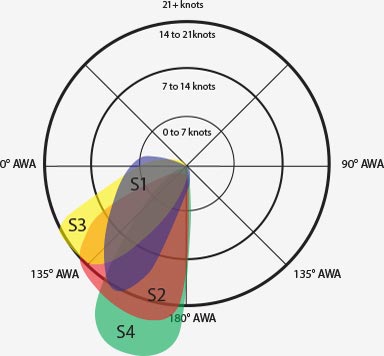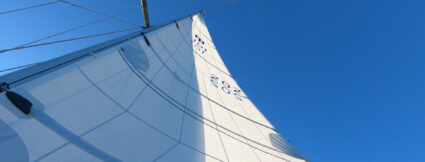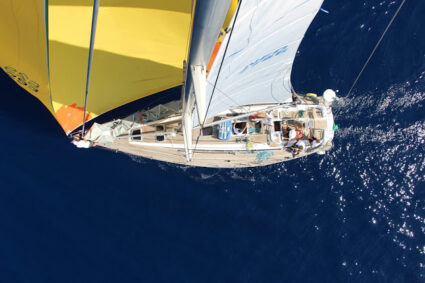
Sailing with a Spinnaker
Sailing with very light winds? Then you need a light weather sail, such as a spinnaker. Sailmaker de Vries Maritiem produces high quality light weather sails With which it is good sailing in the wide wind. You make a nice speed despite the light wind. Moreover, these sails often look beautiful on a ship thanks to the shape and color of the sail.
What is a spinnaker?
A spinnaker is a type of headsail. It is a light weather sail, made of very thin sailcloth. The surface area is very large to propel a ship as well as possible in light weather. The shape of the sail is symmetrical, this prevents the sail from turning when a jibe is made. It looks a lot like a gennaker. A gennaker is an asymmetrical light weather sail.
Spinnakers are 'flying sailed', which means that they are sailed free from the bow on a boom. In terms of wind direction, this sail can be used on leeward to leeward courses. You cannot sail downwind with it.
Full-radial, tri-radial and radial-head
We distinguish three types of spinnakers: the full-radial, the tri-radial and the radial-head. The shape and construction of the sail are different for these three types. For a complete picture and estimate of what suits your ship we would like to speak to you personally.
The so-called full-radial is available in several types: the runner and the reacher. The runner is sailed on very wide courses, and the reacher can be sailed on both half wind and wide wind.
A tri-radial is stable and retains its shape due to its special construction. Racing sailors in particular make great use of this somewhat flatter-cut headsail, which is ideal for sailing under a wide and half wind. A height of 80 degrees is feasible and the headsail is designed to withstand heavy loads. Zeilmakerij de Vries Maritiem has also designed a trunk for this sail.
The radial-head has 'broad shoulders' and a substantial bulge. This sail is therefore ideal for sailing into the wind. Half wind is already a lot more difficult for the radial-head. Therefore, this headsail comes into its own on the broad courses. Especially for more wind, this all-rounder can be reinforced with radial corners.

Difference spinnaker and genaker
The spinnaker and gennaker are both light weather sails. The main difference is the shape: a spinnaker is a symmetrical sail, and a gennaker an asymmetrical sail. This ensures that a gennaker is not sailed right downwind, but on sharper courses.
What is a bulging janitor?
A convex sail is a light weather sail made of spinnaker cloth. This sail has a smaller surface area. The convex john can be sailed either flying or with levers on the forestay. Leuvers are used most often. A convex john can be single or double. Another name for the bulbous spinnaker is D.R.S. (Drifter Reacher Spinnaker). The convex gannet has been further developed into the gennaker.
Reven
A spinnaker cannot be reefed. For easy setting and ironing of this headsail, Zeilmakerij de Vries Maritiem has designed a Slurf, the ironing cover.
How does a light weather sail work?
A spinnaker is not 'standard' on a sailing vessel, but is brought in when the conditions are suitable. Light winds provide the perfect conditions for this type of sail. The sail is often packed in a kind of trunk or sock (or 'ironing bag'), and this whole thing is then packed into a sail bag. The sail and the cover are fastened, and then the sail can be hoisted. This headsail is sailed in flight, on a tree.
Once the sail is hoisted, a smooth motion pulls up the ironing cover, allowing the sail to catch wind and bulge. Then you trim the sail and the ship 'flies' through, with just a little wind!
What size?
Our sail making shop has made thousands of spinnakers, in many different sizes, types and shapes. We can also make the perfect light weather sail for your boat. What size you need, we can determine together. We look at any previous light weather experiences on your ship, we know similar ships and spinnakers and we know what innovations are available. Together we determine which size is most suitable for your ship.
Buy Spinnaker
We have many different types of spinnakers for sale. How much does such a sail cost? That always depends on the size, material and finish.
Would you like to know how much a spinnaker costs for your boat? Then easily request a free quote. You will often have a response from us within 24 hours. In case of heavy traffic it may take a little longer.
Want to buy a spinnaker right away?
Request an offer ?
Ask a question or request a price estimate directly!
Frequently Asked Questions
A spinnaker is a type of headsail. It is a light weather sail, made of very thin sailcloth. The surface area is very large, to propel a ship in light weather. The shape of the sail is symmetrical, so it does not turn when a jibe is made. It looks a lot like a gennaker, a gennaker is an asymetric light weather sail.
A spinnaker is a very lightweight sail, which is sailed flying, in front of the ship on a spinnaker boom. Because it is very light, and has a large surface area, this sail can still give a ship with little wind a nice speed. A spinnaker is often hoisted using a trunk or sock.
A spinnaker boom is a very strong pole that fixes the spinnaker. This prevents the sail from flapping.
The ideal size spinnaker is different for every ship. The size of the ship, the weight, the rigging... these are all factors that need to be considered when determining the size of the spinnaker. We are happy to help you get the right size spinnaker.
The shape of a spinnaker sail is symmetrical, which means that the sail does not turn when a jibe is made. An asymetric spinnaker is a gennaker: an asymetric light weather sail.


